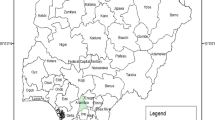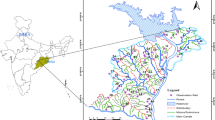Abstract
The area of study lies at the northeastern part of Nile Delta. Global shoreline regression and sea-level rise have their own-bearing on the groundwater salinization due to seawater intrusion. A new adopted approach for vulnerability mapping using the hydrochemical investigations, geographic information system and a weighted multi-criteria decision support system (WMCDSS) was developed to determine the trend of groundwater contamination by seawater intrusion. Six thematic layers were digitally integrated and assigned different weights and rates. These have been created to comprise the most decisive criteria used for the delineation of groundwater degradation due to seawater intrusion. These criteria are represented by the total dissolved solids, well discharge, sodium adsorption ratio, hydrochemical parameter (Cl/HCO3), hydraulic conductivity and water types. The WMCDSS modeling was tried, where a groundwater vulnerability map with four classes ranging from very low to high vulnerability was gained. The map pinpointed the promising localities for groundwater protection, which are almost represented by the very low or low vulnerability areas (53.69 % of the total study area). The regions having high and moderate groundwater vulnerability occupy 46.31 % of total study area, which designate to a deteriorated territory of groundwater quality, and needs special treatment and cropping pattern before use. However, the moderate groundwater vulnerability class occupies an area of about 28.77 % of the total mapped area, which highlighted the need for certain management practices to prevent the saltwater intrusion from expanding further to the south. There was a good correlation of the constructed vulnerability map with the recently gathered water quality data and hydrochemical facies evolution. The plotting of water quality data on Piper trilinear diagram revealed the evolution of freshwater into the mixing and the saline zones as an impact of seawater intrusion, which validates the model results.












Similar content being viewed by others
References
Aller L, Bennett T, Lehr JH, Pretty RJ, Hackett G (1987) DRASTIC: a standardized system for evaluating groundwater pollution potential using hydrogeologic setting. U.S. EPA, Robert S. Kerr Environmental Research Laboratory, Ada, p 622 (EPA Rep. 600/287/035)
Anonymous (1985) Simplified laboratory procedures for wastewater examination: special publications for water pollution control. Water pollution control federation, Washington, DC
Anthony JT, Emily LI, Frank DV (1988) Assessing groundwater vulnerability using logistic regression. In: Proceedings for the source water assessment and protection 98 conference, Dallas, TX, pp. 157–165
Ayers RS, Westcot DW (1985) Water quality for agriculture, FAO irrigation and drainage: Paper no. 29, Rev. 10. U.N. Food and Agriculture Organization, Rome
Baker DB (1990) Groundwater quality assessment through cooperative private well testing: AOHIO example. J Soil Water Conserv 45:230–235
Bear J, Cheng AHD, Sorek S, Ouazar D, Herrera I (1999) Seawater intrusion in coastal aquifers-concepts, methods and practices: theory and applications in transport in porous media. Kluwer Academy Publishers, Dordrecht
Becker RH, Sultan M (2009) Land subsidence in the Nile Delta: interference from radar interferometry. The Holocene 19(6):949–954
Biswas AK (1993) Land resources for sustainable agricultural development in Egypt. Ambio 22(8):556–560
Carnoda A, Carillo-Rivera JJ, Huizar-Alvarez R, Graniel-Castro E, (2004) Salinization in coastal aquifers of arid zones: an example of Santo Domingo, Baja California Sur, Mexico. Environ Geol 45(3):350–366
Choudhury K, Saha DK, Chakraborty P (2001) Geophysical study for saline water intrusion in a coastal alluvial terrain. J Geophys 46:189–200. doi:10.1016/S0926-9851(01)00038-6
Coleman JM, Robert HH, Murray SP, Salama M (1981) Morphology and dynamic sedimentology of the eastern Nile Delta shelf. Mar Geol 42:301–312
Collins WH, Easley DH (1999) Freshwater lens formation in an unconfined barrier island aquifer. J Am Water Resour Assoc 35:1–2
Connell LD, Van den Daele G (2003) A quantitative approach to aquifer vulnerability mapping. J Hydrol 276:71–88
Cressie N (1993) Statistics for spatial data. Wiley, New York
Davis RA (1997) The evolving coast. Scientific American Library, New York
El Banna M, Frihy O (2009) Human-induced changes in the geomorphology of the northeastern coast of the Nile Delta. Egypt Geomorphol 107:72–78
El Fayoumy IF (1968) Geology of groundwater supplies in the eastern region of the Nile Delta and its extension in north Sinai: PhD thesis. Faculty of Science, Cairo University, Egypt, pp 1–207
El-Asmar HM, Hereher ME (2010) Change detection of the coastal zone east of the Nile Delta using remote sensing. Environ Earth Sci. doi:10.1007/s12665-010-0564-9
Elewa HH (2010) Potentialities of water resources pollution of the Nile River Delta, Egypt. Open Hydrol J 4:1–13
Elewa HH, El Nahry AH (2008) Hydro-environmental status and soil management of the Nile River Delta. Egypt Environ Geol 57:759–774 (Published online 2008)
EPA (1986) Quality criteria for water. EPA 440/5-86-001
ESRI (2007) ArcGIS v. 9.3.3, Environmental System Research Institute Inc. (www.esri.com) (accessed Jan 2011)
GCSA (General Civil Survey Authority) (1925) Damietta topographic sheet, 1; 100,000 scale
GCSA (General Civil Survey Authority) (1949) Damietta topographic sheet, 1; 100,000 scale
Geirnaert W, Laeven MP (1992) Composition and history of ground water in the western Nile Delta. J Hydrol 138(1–2):169–189. doi:10.1016/0022-1694(92)90163-P
Hammouri N, El-Naqa A (2008) GIS based hydrogeological vulnerability mapping of groundwater resources in Jerash Area-Jordan. Geofisica Int 47(2):85–97
Hem J (1985) Study and interpretation of the chemical characteristics of natural water. U.S. Geological Survey Water Supply Paper 2254, 3 edn. Reston, VA
Hereher ME (2009) Inventory of agricultural land area of Egypt using MODIS data. Egypt J Remote Sensing Space Sci 12:179–184
Hölbling D (2009) Snapshot: Erdas Imagine Objective 9.3.3 In: GIS BUSINESS (8) pp. 47–51
Ingel JD Jr, Crouch SR (1988) Spectrochemical Analysis. Prentice Hall, New Jersey
Isaaks EH, Srivastava RM (1989) An Introduction to Applied Geostatistics. Oxford University Press, New York 561 p
Kalinski RJ, Kelly WE, Bogardi I, Ehrman RL, Yamamota PD (1994) Correlation between DRASTIC vulnerabilities and incidents o VOC contamination of municipal wells in Nebraska. Groundwater 32(1):31–34
Kerambrun P (1986) Coastal lagoons along the southern Mediterranean coast (Algeria, Egypt, Libya, Morocco, Tunisia) description and bibliography. UNESCO Rep Marine Sci 34:84
Kostelnick J, McDermott D, Rowley RJ (2009) Cartographic methods for visualizing sea level rise. In: Proceedings of the 14th international cartographic conference, November, Santiago, Chile
Lobo-Ferreira JP, Chachadi AG, Diamantino C, Henriques MJ (2007) Assessing aquifer vulnerability to seawater intrusion using GALDIT Method. Part 1: application to the Portuguese aquifer of Monte Gordo. In: 4th INTERCÉLTICO water in celtic countries: quantity, quality and climate variability, Guimarães, 11 a 14 de Julho de 2005, p 10
Lu D, Mausel P, Brondizio E, Moran E (2004) Change detection techniques. Int J Remote Sens 25(12):2365–2407
Maas RP, Kucken DJ, Patch SC, Peek BT, Van Engelen DL (1995) Pesticides in eastern North Caroline rural supply wells: land use factors and persistence. J Environ Qual 24:426–431
Mehnert E, Jennings AA (1985) The effect of salinity-dependent hydraulic conductivity on saltwater intrusion episodes. J Hydrol 80(3–4):283–297
NARSS (National Authority for Remote Sensing and Space Sciences) (2011) Land/water resources of the Nile basin and its downstream using remote sensing and GIS techniques: hydrogeologic assessment of northeastern Nile Delta using remote sensing and GIS techniques. Internal unpublished report submitted to NARSS, p 185
Nobr RCM, Rotunno OC, Mansur WJ, Nobre MMM, Cosenza CAN (2007) Groundwater vulnerability and risk mapping using GIS, modeling and fuzzy logic tool. J Contam Hydrol 94:277–292
NRC (National Research Council) (1993) Groundwater vulnerability assessment: contamination potential under conditions of uncertainties. National Academy Press, Washington, DC, p 185
Nyerges TL (1992) Coupling GIS and spatial analytic models. In: Spatial data handling, Charleston, South Carolina, USA, August 1992, pp. 534–543
Panagopoulos GP, Antonakos AK, Lambrakis NJ (2006) Optimization of the DRASTIC method for groundwater vulnerability assessment via the use of simple statistical methods and GIS. Hydrogeol J 14:894–911
Polemio M (2005) Seawater intrusion and groundwater quality in the Southern Italy region of Apulia : a multi-methodological approach to the protection. In: Maraga F, Arattano M (eds) Progress in surface and subsurface water studies at the plot and small basin scale. UNESCO, IHP, Malaysia, pp 171–178
Richter BC, Kreitler WC (1993) Geochemical techniques for identifying sources of groundwater salinization. CRC Press, NY. ISBN 1-56670-000-0
SAFEL (Swiss Agency for Environment, Forests and Landscape) (1998) Practical guide: groundwater vulnerability mapping in karstic regions (EPIC); application to groundwater protection zones. Tech Rep VU2504E (SAFEL). Bern, Switzerland
Said R (1981) The geological evaluation of the River Nile. Springer, New York, p 151
Sallouma MKM (1983) Hydrogeological and hydrochemical assessment of the Quaternary aquifer in the eastern Nile Delta, Egypt: PhD thesis. Faculty of Science, Ain Shams University, Egypt, p 166
Schlumberger (1995) Well evaluation conference of Egypt. Schlumberger Technical Editing Services, Chester
Schneider JC, Kruse SE (2005) Assessing selected natural and anthropogenic impacts on freshwater lens morphology on small barrier islands: Dog Island and St. George Island, Florida. USA Hydrogeol J 14:131–145
Sestini G (1992) Implications of climatic changes for the Nile Delta. In: Jeftic L, Milliman D, Sestini G (eds) Climatic change and the Mediterranean. Edward Arnold, London, pp 535–601
Singh A (1989) Digital change detection techniques using remotely sensed data. Int J Remote Sens 10:989–1003
Snow G (1990) Identification of sources of saline intrusion in a confined aquifer system, Salinas Valley, California. Ground Water Manag 1:20–21
Somay MA, Gemici Ü (2009) Assessment of the salinization process at the coastal area with hydrogeochemical tools and geographical information systems (GIS): Selçuk Plain, Izmir, Turkey. Water Air Soil Pollut 201:55–74
Stanley DJ (1988) Subsidence in the northeastern Nile Delta: rapid rates, possible causes, and consequences. Science 240(4851):497–500. doi:10.1126/Science.240.4851.497
Stanley DJ, Warne AG (1993) Nile Delta: recent geological evolution and human impact. Science 260:628–634
Syvitski JPM (2008) Deltas at risk. Sustain Sci 3:23–32
Tantawi MA (1998) Hydrogeochemical and isotopic assessment of the Quaternary aquifer in the Eastern Nile Delta, Egypt. El-Minia Sci Bull 11:17–45
Thirumalaivasan D, Karmegam M, Venugopal K (2003) AHP-DRASTIC: software for specific aquifer vulnerability assessment using DRASTIC model and GIS. Environ Model Softw 18:645–656
Todd DK (1989) Sources of saline intrusion in the 400-foot aquifer, Castroville area, California. Report for Monterey country flood control and water Conservation District, Salinas, California, p 41
USEPA (1993) A review of methods for assessing aquifer sensitivity and groundwater vulnerability to pesticide contamination: report no. EPA 813-R-93-002. United States Environmental Protection Agency, Washington, DC
USNAS (United States National Academy of Sciences) (2008) Understanding and responding to climate change. http://americasclimatechoices.org/climate_change_2008_final.pdf (Retrieved 30 May 2010) (Most scientists agree that the warming in recent decades has been caused primarily by human activities that have increased the amount of greenhouse gases in the atmosphere)
Vengosh A, Ben-Zvi A (1994) Formation of a salt plume in the Coastal Plain aquifer of Israel: The Be’er Toviyya region. J Hydrol 160:21–52
Vias J, Andrea B, Perles M, Carrasco F (2005) A comparative study of four schemes for groundwater vulnerability mapping in a diffuse flow carbonate aquifer under Mediterranean climatic conditions. Environ Geol 47:586–595
Zaid SM (2006) Geo-environmental study of Eastern Nile Delta, Egypt: PhD thesis. Faculty of Science, Zagazig University, Egypt, p 339
Acknowledgments
This study was supported and funded by the National Authority for Remote Sensing and Space Sciences (NARSS), Egypt.
Author information
Authors and Affiliations
Corresponding author
Rights and permissions
About this article
Cite this article
Elewa, H.H., Shohaib, R.E., Qaddah, A.A. et al. Determining groundwater protection zones for the Quaternary aquifer of northeastern Nile Delta using GIS-based vulnerability mapping. Environ Earth Sci 68, 313–331 (2013). https://doi.org/10.1007/s12665-012-1740-x
Received:
Accepted:
Published:
Issue Date:
DOI: https://doi.org/10.1007/s12665-012-1740-x




